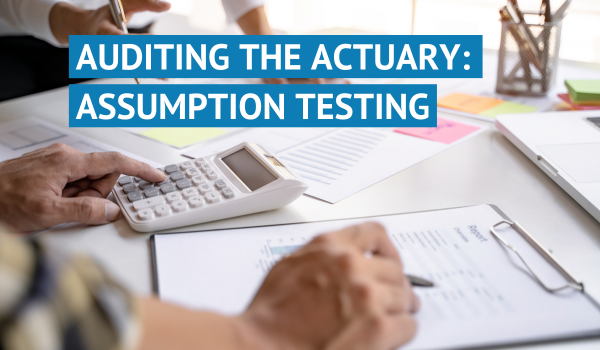What Auditors Need to Know About Census Testing
January 9, 2024|Kurtis Thompson

Bottom Line Up Front
- Understanding and verifying census data fields is essential for accurate pension and OPEB valuations under GASB standards.
- As an auditor, pay special attention to police, fire and teacher populations due to their unique retirement patterns and impact on liability calculations.
- The details matter so ensure accuracy in critical data like birth dates, hire dates, and Medicare eligibility, and don’t hesitate to seek advice for any uncertainties in the audit process.
GASB standards for Pension and OPEB valuations have put a burden on the audit community to “Audit the Actuary”. What exactly that means, is left with some ambiguity. It seems obvious, but as an auditor, you shouldn’t need to become an actuary to understand the ins and outs of an actuarial valuation. Yet you must do something to show that you are auditing the actuarial valuation.
Two big areas where you can focus your attention in a way that is reasonable and productive are census testing and review of assumptions. This article will focus on census testing and the steps you can take to make your review of a census effective.
1. Understand the fields on the census file
Actuaries may use software that requires certain fields or create them for their own valuation purposes. Many fields will be self-explanatory (e.g., birth date), but some may not be. If there are fields that you don’t understand it is entirely reasonable to ask the actuary what they are and what purpose they serve.
2. Make Sure The Number of Employees and Retirees Makes Sense
A lot can happen in the process of gathering and consolidating data. If a file containing a certain department’s employees is lost, for example, it may be noticeable in a reduced headcount. A common scenario is that employees who are not eligible for benefits are included on a census file resulting in a large increase in the headcount.
3. Police, Fire, and Teachers
When reviewing a census pay special attention to police and fire employees. They tend to retire earlier which has big impacts on both the liability and service cost associated with those employees. Verifying that the number of police and fire employees is reasonable can be a precaution worth taking. Teachers have a similar, if less pronounced, effect as they have differing termination and retirement rates than the general government or private employees.
4. Birth Dates and Hire Dates
Birth Date and Hire Date are two of the most crucial components of an actuarial valuation. It is worth choosing five to ten (5-10) randomly selected individuals, both active and retired, and verifying that the dates listed on the census file match their actual Birth Date and Hire Date.
Another item to note with Hire Date is some Towns and Cities may update the Hire Date in their system when a participant is promoted or changes departments. What matters from a valuation perspective is the “Original Hire Date”, which should be the same as what is used under the Pension System.
5. Medicare Eligibility
On an OPEB valuation, retirees who are not eligible for Medicare have significantly higher costs, often 3-4 times, than those who are eligible. If a retiree is over 65 and remains enrolled in an “Active” health plan, it is worth verifying that this information is correct.
If you’d like to learn more about Medicare and how it affects OPEB costs, check out our article, Medicare 101 for Municipalities.
As with any audit, it’s about materiality. Birth dates that vary by days or a few months will not materially impact liabilities, but if it’s a systemic issue that should be addressed. The size of the census will also impact the materiality of any particular census anomaly.
If you have questions on the impact of a particular census issue, you should contact the actuary to determine the size, materiality, and if a new report should be issued.
Connect With Us for Further Guidance
We hope this article has provided you with valuable insights into the intricacies of GASB standards for pension and OPEB valuations and the critical role of effective census testing in the auditing process. At Odyssey Advisors, our commitment extends beyond providing actuarial services; we are dedicated to fostering a deeper understanding and clarity in this complex field.
If you have any questions about the content covered in this article, or if you’re seeking advice on specific challenges you’re facing in your auditing processes, we’re here to help. Our team of experienced actuaries is always ready to offer guidance, share expertise, and help you navigate through the nuances of actuarial valuations and audits.
Feel free to reach out to us here. Whether it’s a simple query or a complex scenario, we welcome the opportunity to assist you in enhancing your understanding and practices in this vital area of financial management. Remember, no question is too small, and every detail matters in the pursuit of accuracy and compliance.
Odyssey Advisors – Empowering Auditors with Expertise and Insight.
Categories: OPEB

About The Author Kurtis has been a consultant on the Odyssey Advisors team since 2013 and has developed extensive knowledge and expertise in developing and administering retirement benefit solutions. Kurtis is passionate about helping people achieve the retirement they’ve always dreamed of...
More Insights From This author








